The MLB season is winding down, and we will soon be in the midst of the playoffs. As we look forward to those games, Hot Stove will take a look at some World Series history.
But first, a couple of personal notes.
Tonight, Rita and I will be at a Rainy Day Books event on the Plaza. Joe Posnanski will be interviewed by stats guru Bill James about Joe’s new book, The Baseball 100. If the buzz is any indication, the book is going to be a best-seller.

Remember the Kansas City A’s? I have told the story before of going to the first MLB game in Kansas City. April 12, 1955, at old Municipal Stadium at 22nd and Brooklyn. The Philadelphia A’s had moved to KC. I was 13 years old and baseball crazy. My eighth grade buddy Jay DeSimone and I cut school to go to the afternoon game. We went to at least 15 games that summer, but I changed schools the following year and Jay and I lost contact. We reconnected 55 years later (2010) and started going to games again. We have done it almost every year since. Below, at Kauffman Stadium earlier this month, I’m on the left and Jay’s on the right.

The guy in the middle is former Kansas Citian Bill Wakefield who I met a few years ago through my law partner Irv Blond. Bill and Irv were high school classmates at Pem-Day where Bill was a multi-sport star athlete. He went on to play a few years of pro baseball, including a year with the Mets in 1964. Bill had let me know he was going to be visiting KC, and I told him that Jay and I were going to an afternoon Royals game. He was able to join us and showed up sporting a cap for Katz Drugs, the team he played for in KC’s Ban Johnson League in 1959 and 1960. Bill knew that Jay had also played Ban Johnson ball back in those days for Western Auto. And another coincidence in the small world of Kansas City – Bill was at Municipal Stadium on opening day in 1955 to see that first A’s game.
Three 80-year-old 1959 high school graduates at the ball game (Jay – Northeast, Bill – Pem-Day and Lonnie – Van Horn). Nice reunion for all of us.
Below, Wakefield at 19 in his Katz uniform. This photo ran in the Kansas City Star in July of 1960 under the headline “Bill Wakefield Acts Like Vander Meer.” Bill had just pitched back-to-back no-hitters for Katz, matching up with Johnny Vander Meer, the only MLB pitcher to ever throw successive no-hitters (for the Cincinnati Reds in 1938).

World Series – The Early Years: From 1903 to 1920, there were four dominant teams: the Giants (then in New York) and Cubs in the National League and the A’s (then in Philadelphia) and Red Sox in the American League. They each made it to the World Series five times during those years. Only one of them had a perfect record – Boston won all five times, the last two being in 1916 and 1918 when their top pitcher was Babe Ruth (“The Bambino”). Boston famously sold Ruth to the Yankees after the 1919 season, and the Red Sox did not win another World Series until 2004. That long-term failure is often called the Curse of the Bambino.
The Yankees did not win any pennants from 1903 to 1920 and so did not play in the World Series in those early years. But they got a taste of what was coming when Babe Ruth hit 54 home runs in 1920, his first season as a Yankee. The next year, they were in their first World Series.
100 Years Ago (1921) – Giants v. Yankees: John McGraw’s Giants were back for their sixth Series. Another managerial legend, Miller Huggins, led the Yankees in this inaugural trip for the team. It was also the first World Series to be broadcast on the radio.
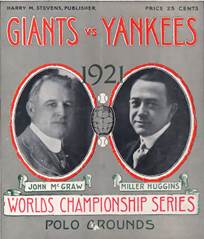
This was the last of the four Series that used the best-of-nine-games format. All games were played at the Polo Grounds where both the Yankees and Giants played in the regular season. Yankee Stadium would not open until 1923.
Babe Ruth was the big draw. He hit 59 homers in the regular season, proving 1920 was no fluke – the live ball era was in full bloom.
The Yankees got off to a fast start by winning the first two games. But this came at a high cost. In Game 2, Ruth seriously scraped his elbow while stealing third base.
The Giants came roaring back in Game 3, winning 13-5. More ominously, Ruth aggravated his elbow injury while sliding into a base. The Yankees announced that his elbow would need be lanced and that Ruth might be out for the Series. The Yankees got a break when rain postponed Game 4, giving Ruth some healing time. He responded by hitting the first Series homer in Yankee history. But it was in a losing cause as the Giants won and evened the Series at two games each.
Ruth played Game 5 with his elbow still bandaged. With the score tied 1-1, he surprised everyone at the Polo Grounds by bunting for a base hit. A double scored him with the go-ahead run, and the Yankees won 3-1 to take the Series lead, three games to two. But then…

The elbow injury, compounded by a knee injury kept Ruth out of Games 6 and 7, both won by the Giants. Ruth also did not start Game 8. With the Giants leading 1-0 in the 9th inning, Ruth came in to pinch hit, but he grounded out. The Giants won Game 8 (1-0) and the World Series (5-3).
The teams also met in the 1922 Series, and the Giants won again. But the Yankees then became the dominant team for the rest of the Roaring Twenties and through the Great Depression and World War II. From 1921 to 1945, they won 14 AL pennants and 10 World Series. Which brings us to…
75 Years Ago (1946) – Cardinals v. Red Sox: In 1946, the Red Sox won the AL pennant for the first time since 1918 – back when Babe Ruth was on their pitching staff. Instrumental in their winning season was the return of Ted Williams who had missed three seasons for the war. Williams was the AL MVP.
The Cardinals, led by Stan Musial, had been to the World Series three times in the previous four years, winning the Series in 1942 and 1944. They did not take the pennant in 1945, no doubt hurt by the absence of Musial who missed the year for the war. Musial was back for 1946 and the Cardinals again won the NL pennant. Musial was the NL MVP.
These two MVP players (below), just a season removed from the war, were now squaring off in the World Series.
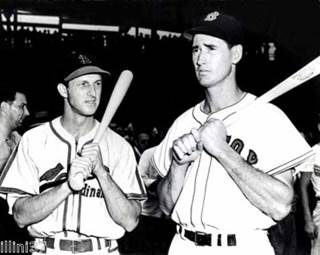
Three singular facts about the 1946 Series: (i) It was the first after World War II; (ii) It was the last under MLB apartheid (Jackie Robinson and Larry Doby would integrate the two leagues in 1947); and (iii) It was the only Series in which Ted Williams played.
The 1946 Series was Boston’s first chance to shake off the Curse of the Bambino. Boston had hope. They now had the best left-handed slugger since Ruth. Alas, Ted Williams was not a factor in the Series – he hit .200 and had no extra-base hits. Stan Musial hit only .222, but had four doubles, a triple and four RBIs. As it turned out, the Series boiled down to one magnificent play in Game 7 – Slaughter’s Mad Dash.
With the Series tied at three games each, the teams played evenly into the 8th inning of Game 7. The score was tied 3-3 and Enos “Country” Slaughter was on first, Harry Walker batting. With Slaughter running on the pitch, Walker got a hit which almost everyone assumed would get Slaughter to third. But Slaughter never stopped, and he scored the go-ahead run on his “Mad Dash” (below). The run held up and the Cards won 4-3 to take the Series. The Curse of the Bambino remained in place.
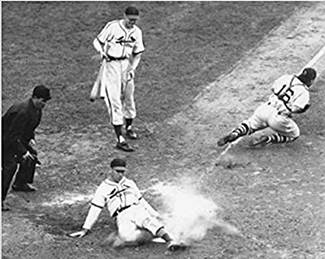
[Royals Trivia: Lorenzo Cain replicated Slaughter’s mad dash in Game 6 of the 2015 ALCS. The Royals were leading Toronto three games to two. In the bottom of the 8th, with the game tied 3-3, Lorenzo Cain walked. Hosmer followed with a single, and Cain never stopped until he slid into home to score the go-ahead run (below). The run held up and the Royals won 4-3 to take the ALCS and move on to the World Series.
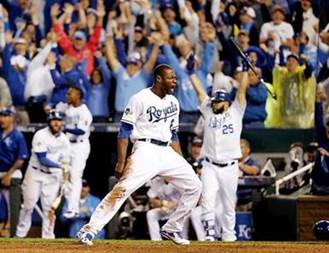
View these two mad dashes by clicking on the names: Slaughter and Cain.]
The Cardinals have long been a strong franchise, winning a total of 11 World Championships. Only the Yankees have won more – 27.
For the Red Sox, it would be another 21 years before they got back to the World Series. That was 1967 and they again lost to the Cardinals. In 1975, lost to the Reds. In 1986, lost to the Mets. But in 2004, again playing the Cardinals….they WON! After 86 years, the Curse of the Bambino was lifted. They have since won three more to bring their total Series wins to nine, behind only the Yankees and Cardinals, and tied with the Philadelphia/Oakland A’s.
75 Years Ago (1946) – Eagles v. Monarchs: While the all-white MLB World Series was being played in Boston and St. Louis, the Negro Leagues World Series pitted J. L. Wilkinson’s Kansas City Monarchs against Effa Manley’s Newark Eagles. Wilkinson had owned the Monarchs since the first Negro League was founded in 1920. Effa Manley is the only woman in the Hall of Fame.
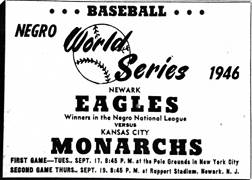
The Monarchs had three Hall of Famers on their roster – Willard “Home Run” Brown and pitchers Satchel Paige and Hilton Smith. The first baseman was Buck O’Neil who led the league in hitting and hit two homers in the Series. Missing from the lineup was Jackie Robinson who played for the Monarchs in 1945. Jackie was in Montreal playing for a Dodgers farm team in anticipation of moving up to the parent team in 1947.
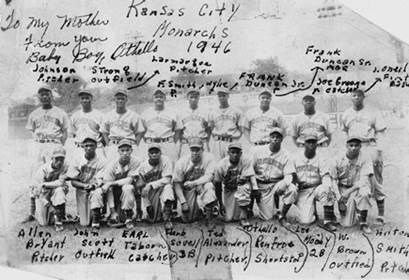
Newark had its own set of Hall of Famers – Two-way pitching and batting star Leon Day; catching legend Biz Mackey who was now the Newark manager; and two young future MLB stars, Monte Irvin and Larry Doby (left to right in photo below).

The Monarchs and Eagles split the first six games, leading to a climactic Game 7 in Newark. Satchel Paige had pitched in three of the first six games with mixed results. Surprisingly, he was a no-show for Game 7. Buck O’Neil has said that Satch may have been busy with Bob Feller putting the finishing touches on a big barnstorming tour set to start the day after Game 7. After Newark beat Kansas City 3-2 to win the Series, several of the Monarchs and Eagles joined Satch’s barnstorming team.
In the stands at the World Series were MLB scouts who were seeing what other players might follow the path of Jackie Robinson. There were several. Newark’s Larry Doby signed with Bill Veeck’s Cleveland Indians, and just weeks after Jackie broke the color line in 1947, Doby became the first Black player in the American League. His Eagles teammate Monte Irvin joined the New York Giants in 1949.
Monarchs third baseman Hank Thompson became the first Black player on two MLB teams, the St. Louis Browns (1947) and New York Giants (1949). Willard Brown played briefly in 1947 for the Browns. In 1948, Satchel Paige joined Larry Doby on the Cleveland Indians team that won the 1948 World Series.
The last Negro League World Series was held in 1948. The Homestead Grays beat the Birmingham Black Barons. The Black Barons won Game 3 when 17-year-old Willie Mays hit a walk-off single. Mays signed with the New York Giants, joining fellow Negro Leaguers Monte Irvin and Hank Thompson (who had both played in the 1946 Negro League World Series). All three were starters when the Giants won the NL pennant in 1951 on Bobby Thomson’s home run. They repeated in 1954 and went on to win the World Series (the one with “The Catch” by Willie). Below, Irvin, Mays and Thompson as Giants.
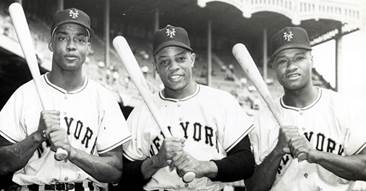
Willie Mays Trivia: The Boston Red Sox reportedly had the first chance to sign Willie Mays. Red Sox owner Tom Yawkey passed – he was in no hurry to have a Black player. Boston would be the last MLB team to integrate (in 1959, 12 years after Jackie Robinson broke the color line). Many feel that Yawkey’s lack of pursuit of Black players was more relevant to the fate of the team than the Curse of the Bambino. The Yawkey family owned the Red Sox from 1933 to 2001 – never won a World Series. Babe Ruth retired in 1934 – surely other curses (a/k/a management decisions) came into play over the next seven decades.
Coming Attractions: In the next Hot Stove post, I will take a look at the World Series from 50 and 25 years ago. Teaser: The MVPs of those Series were Roberto Clemente (1971) and John Wetteland (1996).
Lonnie’s Jukebox – Backup Groups Edition: In 2012, six groups of backup singers and musicians were inducted into the Rock & Roll Hall of Fame. Each group had been integral to the career of a lead singer who was already in the Hall. The groups had been left out when the lead singer was honored, and this retroactive recognition was welcomed by rock ‘n’ roll fans.
Below, the name of each group, the lead singer/induction date and a jukebox selection you can play by clicking on the song title.
The Famous Flames: James Brown was inducted in 1986. When completing his act at the T.A.M.I. concert in 1964, Brown dropped to his knees and members of the Famous Flames draped a cape or towel on him and walked him off the stage. But he kept returning to the microphone. This became a trademark in Brown’s shows for the rest of his career. The selection below is from the T.A.M.I. show.
Selection: “Please, Please, Please”
The Crickets: Buddy Holly was inducted in 1986. In 1957, I heard my first Buddy Holly song, but I did not yet know his name. “That’ll Be the Day” was by “The Crickets,” and the first album for the group was called The “Chirping” Crickets. The Beatles chose their name partially in homage to the Crickets.
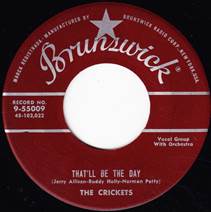
Selection: “That’ll Be the Day”
The Comets: Bill Haley was inducted in 1987. When I was in high school, many of my early 45-rpm records featured “Bill Haley & His Comets.”
Selection: “Rock Around the Clock”
The Miracles: Smokey Robinson was inducted in 1987. The group was first known as the Miracles and then Smokey Robinson and the Miracles. Huge success at Motown.
Selection: “Tears of a Clown”
The Midnighters: Hank Ballard was inducted in 1990. Years ago, Rita and I were with Larry and Diana Brewer at the Grand Emporium and the headline act was Hank Ballard and the Midnighters. Hank received a lot of money in songwriting royalties for “The Twist,” a moderate hit for him and the Midnighters, but a monster hit for the cover by Chubby Checker.
Selection: “Let’s Go, Let’s Go, Let’s Go”
The Blue Caps: Gene Vincent was inducted in 1998. Below, the Blue Caps in their blue caps.
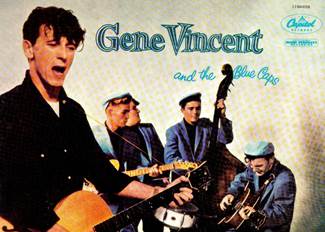
Selection: “Be-Bop-a-Lula”
Covid Booster Shot: Rita and I just got our third Pfizer shots! Our friend John Shipp gave us buttons.
